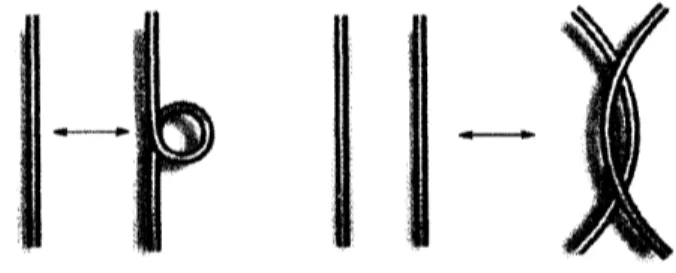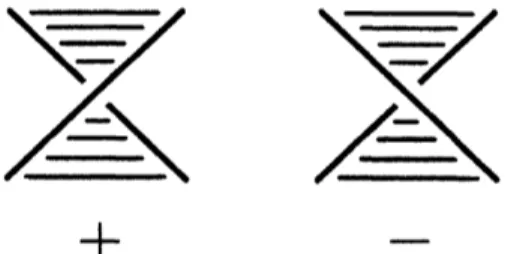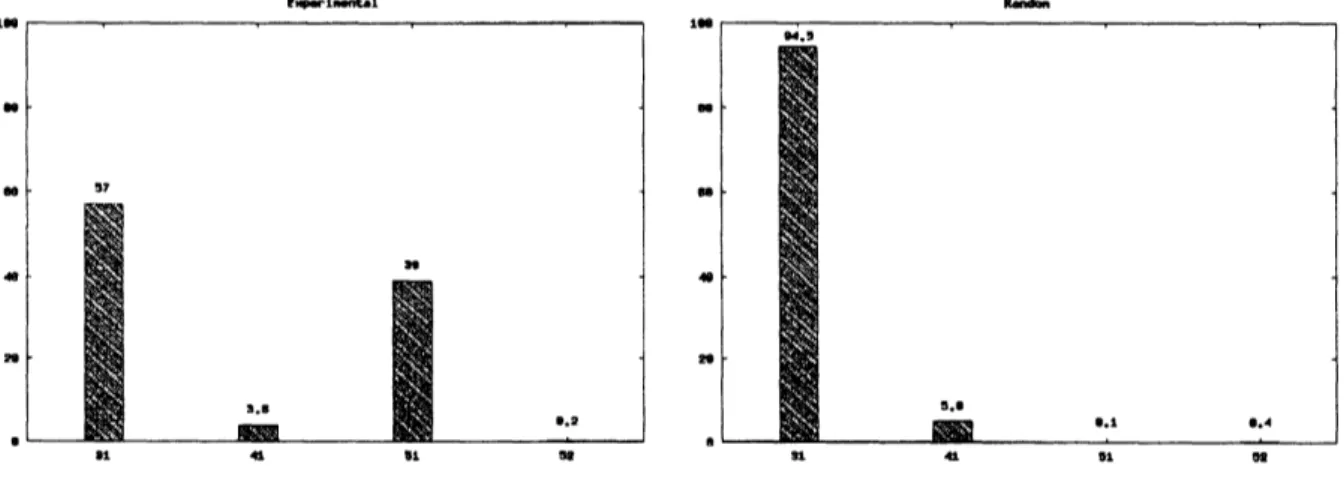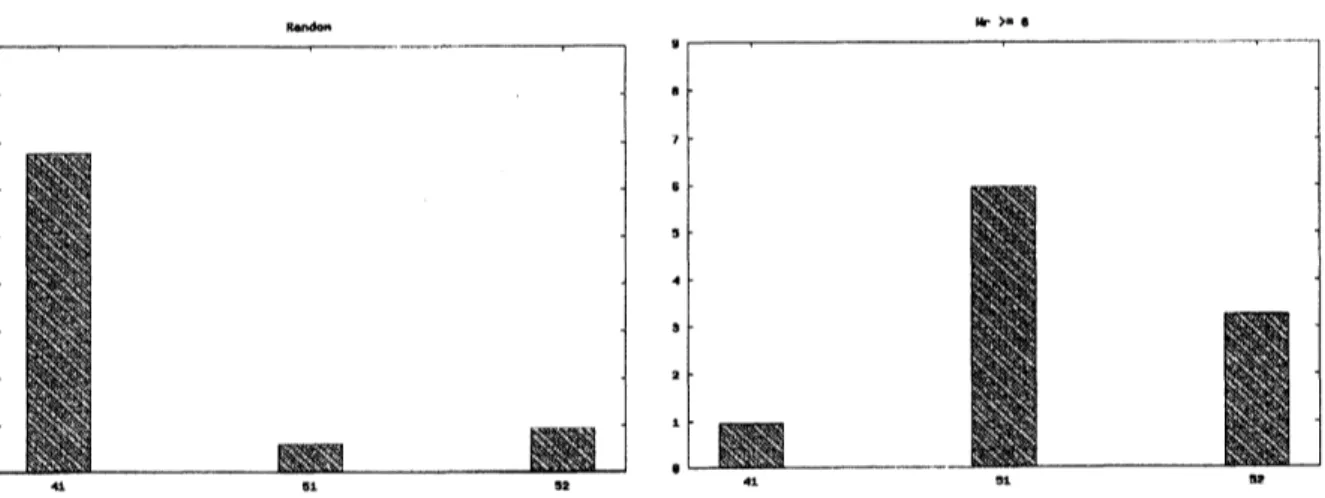Applied
analysis
to DNA knot
by topological
invariants
位相不変量を用いた
DNA
結び目に対する応用解析
Takashi Yoshino and Isamu
Onishi
(Hiroshima University)
吉野 貴史、大西 勇 (広島大学 大学院理学研究科 数理分子生命理学専攻)
Contents
12
1.1 2 1.2 2 1.3 3 1.4 4 1.5 4 1.6 62 PreparationsfromTopology 7
3 Simulations 8
3.1 Alexander polynomial
. . .
.
. . .
.. . . .
..
.. . . .
83.2 Jones polynomial .
.
. . ..
. . ..
. ..
. . .. .
. ..
. . . ..
. .. . .
. . . .. .
..
104 Results and Disucussion 11
4.1 Comparisonofthe results byAlexander polynomial and those by Jones polynomial.
. . .
114.2 Comparison of the results of thesimulation and those ofbiological experiments . . .
. .
. 121
Introduction
1.1
Topological
Structures
of
a
DNA
The structure of DNA isa double helix, much like
a
ladder that is twisted intoa
spiral shape. In 1953the double-helix structure of
a
DNAwas
proposed by J. D. Watson and F. H. Crick with techniqueto build
a
molecular model. The double helix is the ideal model that J. D. Watson and F. H. Crickarrived at from many studies about a DNA and
seven
next importantcharacteristics are emphasized inthe structure.
1. The double helix is formed by two polynucleotide.
2. A purine and apyrimidine ringorient it in the inside of the double helix.
3. The base in complementary relations is bound by hydrogen bond.
4. There is 10.4 base pair per spiral 1 round per minute.
5. As for two polynucleotide ofthe double helix,
a
direction isreverse
(reverse parallel) each.
6. Double helix has two kinds ofgrooves, the majorgroove and the minor groove.
7. The doublehelix is clockwise twining (right handed).
Whenadouble-stranded DNA of the double-helix structureis twisted
more
orit is untied, the doublehelix is
more
twistedas
a whole. Theseare
called the supercoiled structure (a positively supercoiledDNA is the former and
a
negatively supercoiledDNA is the latter, respectively).The ringed supercoiled DNA closed by covalent bond has “the twist” and “the writhe”. “The twist“
is the spiral number of revolutions that
one
chain surrounds the chain ofthe other, that is the numberoftimes that
one
chain completely coils the chain of the other. “The twist$\rangle$in a right-handed spiral is
defined as plus. “The writhe” is
a
number that the double strand coils oneself or the double strand iscoiled cylindricallylikethecordof the telephone. The total valueof”thetwist” and“
the writhe” cannot
be changed unless we cut off the DNA. As
an
enzyme changing topological structure of the DNA, wetakethe transpososome and the topoisomerase for
an
example.1.2
Transpososome
The transpososome is a complex of the transposon and the transposase. The transposon is the base
sequence which
can
performa
transposition on the genome in a cell. An enzyme called transposase,which transposononeselfencodes, is necessary for transposon DNA to perform transposition.
The transposon has the reverse repetitive sequences on the end and the transposase recognizes this
arrangementand cutsa transposonfrom a DNA arrangement. Therefore it is necessary for transposase
to cut each DNA chain at each end of the transposon. The cutting happens in a linkup with the host
DNA adjacent to atransposon. The transposase cuts the DNAto leave the reverserepetitivesequences
(or the part) in the place where atransposon originally
was
in. After a transposonwas
cut, the end ofthetransposon DNA that is the end that transposasecut firstattacks the DNA phosphodiester bond ofa
newinsertionpart. ThisDNA domainiscalledthe target DNA. Because thetranspososome
was
formed,twoends ofthe transposon DNA attack two chains ofthe same target DNA. As aresult ofattack, the
transposonDNA is bound by the covalent bond to the DNA of the target part.
Although thetranspososomechanges topologicalstructuresof the DNA, differentproductsisexpressed
by theglobalstructure of theDNA [1]. Inthe twoplasmidsubstrates pSPIn and pSPDir, the loxP sites
(the targets for the Cre protein) are in inverted (head to head) and direct (head to tail) orientations,
respectively (Fig.1). Theydivideeachplasmid into two domains shown in red and blue. Recombination
mediated by the Cre tetramer would yield a DNA inversion product with pSPIn and apair of deletion
circles withpSPDir.
In a general case, if $n$ interdomainal supercoil nodes ($n$ being odd) were trapped in the unknown
that
an
odd number of trapped nodes would arrange the loxP sites of pSPIn in antiparallel alignment.For the Cre deletion reaction in pSPDir,
an
additional node $(|n|+1=even)$ has to be introduced forthe antiparallel arrangement of the loxP sites (Lower
area
ofFig.1). Theproductsofdeletionwould bea
pair of catenated circles linked by $(|n|+1)$ crossings. Thege nodes arepreserved in the recombinationproducts, and report on the DNA topology within the synapse. The location of the loxP sites in these
plasmids is such that the hybrid synapse has very little chance of accidentally acquiring interdomainal
nodes, depending
on
the loxP orientation.$p\nu u$
$\alpha m$
$-r-$
Fig. 1 Cre Recombination from a Preassembled Synapse
1.3
Topoisomerase
The topoisomerase is theenzymewhich
can
change structures of the DNA by cuttingthesingle strandor the double strand of the DNA temporarily.
Thetopoisomerase hastwotypes. TypeItopoisomerasescut thesinglestrand of the DNAtemporarily
and connect it again after dipping theother single strand. Type II topoisomerasescut the double strand
temporarily and close afterdipping another double strand which is not cut.
Bothaprokaryote andorganism withanucleus havetypeI andII topoisomerase whichcan
remove
thesupercoiledstructure fromthe DNA. Prokaryotes possess twostructurallysimilar type II topoisomerases,
Gyrase and Topo IV, which differ in their function. Gyrase generates negative supercoils, but Topo IV
relaxes positive supercoils. In addition, it has reported that Gyrase is strongly bound with DNA, but
Topo IV is weak [2].
The globalstructure ofDNAstrongly ties tothe expression pattem of DNA bythe propertyofTopo
IV and Gyrase, since the different DNA structure tends to produce different DNA modification even
under the
same
local condition. For example, when Gyrasewas
added to the positively supercoiledDNA, Gyrase unties DNA since Gyrase generates
a
negatively supercoils, but when Gyrasewas
addedto thenegatively supercoiled DNA, Gyrase twists DNA more. Thus, the global structure ofthe DNA is
important foran enzyme.
It is known that the global topologicalstructures ofDNA tend to affect theexpression oftranscripts.
DNA is affected by other nucleic acids and enzymes in the process of DNA transcription. The global
structure of DNAstrongly ties tothe expression patternof DNA, sincethe different DNAstructuretends
to produce different DNA modification even under the same local condition. Then it has been reported
that the global topologicalstructures of DNA influences expression of transcripts by performing various
DNA in
a
phage.1.4
Structures
of a
phage
A phage is
a
virus which infects bacteria. It is well known that It is well known that it has tails anda
regular icosahedral head(see Fig.2). A phage is the simplest system to studya
basic process of life.The genomeis small generally and thegenomereproduceonly after invadingahostcell (abacteriacell).
Then
a
gene isexpressed. A genome tends to be rearranged while infection.Because the system is simple,
a
phagewas
used verywell at the molecular biological dawn. Actually,a
phagewas indispensable forthedevelopmentof this field. Thesystem is also most suitable for astudyof
theDNA replication, thegeneexpressionandbasic structuresof the recombination today. Furthermore,
a phage is important
as
a vector of the DNA recombination, and it is used to examine the activityinducting variation ofvarious compounds.
Phages usually pack genomes (generally, DNA) to a mantle consisting of subunits of the protein. A
subunithas a one making headstructure (packing genomes) anda onemaking tail structure. The phage
particle is glued to the outside of the bacteria host cell with
a
tail and injectsa
phage genome toa
cell.Because each phage glues to
a
specific molecule (usually, protein) in the cell surface, onlya
cell havinga coping acceptor is infectedwith aphage.
A phage has a double-stranded DNA controlling
a
genetic informationin the head. The linearDNApacked in the head ofphages forms various types of knots. As the part ofknots, Fig.3 shows knots $0_{1}$,
$3_{1},4_{1},5_{1},5_{2},6_{1},6_{2},6_{3},7_{1},7_{2},7_{3},7_{4},7_{5},7_{6}$ and $7_{7}$.
It is the important step of the DNA studies to investigate thefractions of various types of knots and
clarify the
reasons
of thephenomena.Fig. 2 A bacteriophage
1.5
Results of biological experiments
$o_{\dagger \mathcal{O}^{3_{1}}\ ^{4_{1}}\mathfrak{H}^{5_{t}}\Phi^{5_{2}}\mathfrak{H}}$
$6_{1}$
馨
$6_{3}7_{l}\otimes\otimes^{\gamma_{l}}\oplus$ $7_{3}7_{4}\otimes\otimes^{\gamma_{s}}\otimes 7_{6}\^{7_{7}}\Re$Fig. 3 Theprimeknotshavingbelow 7crossing
The DNA insidethe phage was examined types of knots which is made inside the phage and the
proba-bility by J. Arsuaga ct. al. [3]. First, purifiedDNAwasanalyzed by two-dimensionalgelelectrophoresis.
By gel electrophoresis, we can distinguish
some
knot types with the number of thesame
crossingnum-ber. To the direction of I of Fig.4, DNA samples
were
run
at 0.8$V/cm$ for 40$h$ atroom
temperature.Aftera 90’ rotation ofthe gel, the direction ofIIofFig.4was
run
inthe same elcctrophoresis buffer at3.4$V/cm$for $4h$at room temperature. This gel electrophoresis segregated the linearDNA molecules and
segregated knots with six and more crossings to two groups. Knot populations of low crossing number
$\underline{1i}$
Fig. 4 Theresult of gelelectrophoresis by J. Ar- Fig. 5 The enlarged pictureof Knotpopulations
suagaet. al. [3] of lowcrossing number in Fig.4
Next, the projection obtained by this experiment
was
compared with the projection of known knottypesto examine the knots corresponding DNA knots separated by electrophoresis (see Fig.6). The gel
velocityat lowvoltageof individual knotpopulationsresolved bytwodimensionalelectrophoresis (Right
ofFig.6) iscomparedwith the gel velocityat low voltage of twistknots $(3_{1},4_{1},5_{2},6_{1}$ and $7_{2})$ ofa $10-kb$
nicked plasmid (Center ofFig.6) and with known relative migration distances of
some
knot types (LeftofFig.6). By thiscomparison,
some
knot typesof each population are distinguished, Inaddition to theunambiguous knots $3_{1}$ and $4_{1}$, the knot population of five crossings matched the migration ofthe knot
$5_{1}$
.
The knot $5_{2}$ appeared to be negligible or absent. The knot population ofseven
crossings matchedthe migration of the torusknot $7_{1}$ rather than the twist knot $7_{2}$. Yet, we cannot identify this gel band
as
the knot $7_{1}$, becauseother possible knot types ofseven
crossings cannot be excluded.Then, several indicators led us to believe that the second arch ofthe gel ($6’\sim 9’$ ofFig.5) consists of
mainly compositeknots (seeDef.2.6 in Chapter 2). First,the archstarts at knot populationscontaining
six crossings, and
no
composite knots of fewer than six crossings exist. Second, the population of sixcrossingsmatched themigrationat lowvoltage of thegrannyknot (compositeof
a
$3_{1}$ plusa
$3_{1}$, indicatedas
$3_{1}\# 3_{1})$ , although the squareknot (theotherpossible compositeof six crossings, $3_{1}\neq-3_{1}$) cannot beexcluded. Third,consistent with the low amount of$4_{1}$ knots,the size of theseven-crossing subpopulation
isalso reduced; thus,anycompositeseven-crossing knotis$3_{1}\# 4_{1}(or-3_{1}\neq 4_{1})$. Theincreasedgel velocity
at high voltageof composite knots relative to prime knots (seeDef.2.5 in Chapter2) ofthe
same
crossing$3_{1}$ $4_{1}$ $S_{7}$ 迦 $s_{1}us_{\uparrow\ovalbox{\tt\small REJECT} 6_{1}}$ $7_{1}$ $7_{2}$
Fig. 6 Upper areaof the gel picture showing knot populations of low crossing number
Densitometer readings confirmed theapparent scarcity of the knot of four crossings (knot $4_{1}$) relative
to the other knot populations in the main arch of the gel. Fig.7 shows the results of the fractions of
knots $3_{1},4_{1},5_{1}$ and $5_{2}$ by biological experiments. However, the scarcity of the knot $4_{1}$ relative to the
knotof three crossings (knot $3_{1}$) and to other knotpopulationsis enhanced if
we
make the correction forDNA molecules plausibly knotted outside the viral capsid. In such a case, one can predict that 38% of
the total number of observed $3_{1}$ knots and 75% of the observed$4_{1}$ knots are formed by random knotting
in free solution.
Fig. 7 The results of thefractionsofknots$3_{1},4_{1},5_{1}$ and$5_{2}$ by biologicalexperiments [3]
1.6
Outline of this
study
Tostudy the geometryofthe DNA inside the phage, we simulated thefractions ofthe varioustypesof
knots and compared to those ofbiological experiments.
First,
we
simulated under the assumption that DNA knotsinside the phagewere
generated at random.WithMersenne Twisterwe randomly made the knot topology having$n$ crossings $(n=3,4, \cdots, 8)$
.
Thisprocess
was
repeated 1,000,000 times to obtain 1,000, 000 knots. Then we classified these knots withand
we
considered themean
value of all trials as the conclusive fractions of the above-mentioned types of knots.Next,
we
examined “the writhe value” $Wr$ at each crossing. After eliminating matrices having thesmall value of the total amount $\sum Wr$,
we
performed thesame
simulationon
the remaining matrices.The fractions of the knots $3_{1},4_{1},5_{1}$ and $5_{2}$ after considering “the writhe value”
were
similar to thebiological results.
2
Preparations
from
Topology
Def. 2.1 (Alexander matrix) Let $G$ be a group and let $\alpha$ : $Garrow G/[G, G]$ be the Abel map. The
image $A(G, \alpha)$ of Jacobian by the Abel map $\alpha$ is called Alexander matrix of$G$
.
Def. 2.2 (Alexander polynomial) The$g$. $c$. $d$. of determinant of
$(n-1)x(n-1)$
submatrix of$n\cross n$Alexander matrix is called Alexander polynomial.
Def. 2.3 (Trivial knot) Let $K\subset S^{3}$ be
a
knot. If there exists $K\subset S^{2}$ fora
two-dimensional sphere$S^{2}\subset S^{3}$, then $K$ is calledthe trivial knot,
Def. 2.4 (Connected
sum
ofknot) Let $K_{1}\subset S^{3},$ $K_{2}\subset S^{3}$ be knots and let $B_{1}=S^{3}-intN(x_{1})$,$B_{2}=S^{3}-intN(x_{2})$ for points $x_{1}\in K_{1},$ $x_{2}\in K_{2}$
.
Ifwe
set $Si=\partial B_{i}$ $(i=1,2)$, then $S_{i}$ isa
two-dimensionalsphere and $K_{i}\cap Si$ is
a
one-dimensional sphere in $S_{i}$.Then
we
identify$S_{1}$ with $S_{2}$ and identify$K_{1}\cap S_{1}$ with $K_{2}\cap S_{2}$ by ahomeomorphic mapping $(S_{1},$ $K_{1}\cap$$S_{1})arrow(S_{2}, K_{2}\cap S_{2})$, and
we
connect $(B_{1}, K_{1}\cap B_{1})$ and $(B_{2}, K_{2}\cap B_{2})$.
The obtained knot $K\subset S^{3}$ iscalled the connected sumof$K_{1}$ and $K_{2}$, we use the notation$K_{1}\# K_{2}$
.
Conversely, it is called that $K$ is decomposed $K_{1}$ and $K_{2}$
.
Def. 2.5 (Prime knot) For thearbitrary decomposition $K=K_{1}\# K_{2}$ of the knot$K$, if at least
one
of$K_{1}$
or
$K_{2}$ is the trivialknot, then $K$ is called the prime knot. However, we define that the trivial knotis not the prime knot.
Def. 2.6 (Composite knot) If there exists a decomposition $K=K_{1}\# K_{2}$ of the knot $K$ such that $K_{1}$
and$K_{2}$ is the non-trivial knotwhich is not prime, then $K$ is called the composite knot.
Def. 2.7 (Skein relation) Let$t$bethenonzerocomplexnumberand let $L_{+},$ $L$-and$L_{0}$be three knots
thatonly one part crosseslike a Fig.8 and the other part is totally same.
Then
$tV_{L_{+}}(t)-t^{-1}V_{L_{-}}(t)=-(t^{1/2}-t^{-1/2})V_{L_{0}}(t)$
is called Skein relation.
$\backslash \nearrow\backslash L_{+}$ $\backslash _{L_{\sim}}\nearrow’$ $)_{L_{O}}($
Fig. 8 Three knots $L+,$ $L$-and $L_{0}$
Def. 2.8 (Jones polynomial) The polynomial $V_{L}(t)$ such that Skein relation hold is called Jones
Def. 2.9 (Bracket polynomial) The polynomial $<D>$ ofone variable $A$ obtained by applyingnext
three rules tothe link diagram $D$ is called Bracket polynomial:
(i)
$<U>=1$
;(ii) $<DU>=-(\mathcal{A}^{2}+A^{-2})<D>$; (iii) $<’\backslash ’>=A<\wedge>+A^{-1}<)$$(>$;
$<^{\backslash }\Gamma\backslash >=A<)(>+A^{-1}<\wedge>;\vee$
where $U$is$a$ trivialknot, $DU$is anunion with
a
trivial knot and weapply (iii) locally at each crossingofthe link diagram.
Then for the link diagram $D$ of
an
arbitrary knot $L$ withthe direction, Jones polynomial $V_{L}(t)$ has arelation with Bracket polynomial $<D>$ by
$V_{L}(A^{-4})=(-\mathcal{A}^{3})^{-\omega(D)}<D>$,
where$\omega(D)$ is thesum of”thewrithevalue” ateach crossingofthe link diagram$D$ (seeSection 3.1.1),
It is known that the Alexander polynomial and Jones polynomial, which are the invariant forknots,
is effectively used for the classification of knots based on the topology. We can classify all prime knots
having below 8 crossing by a combination of the value of $\Delta(-2)$ and $\Delta(-3)$ when we
use
Alexanderpolynomial $\Delta(t)$
.
Then we can distinguish the mirror images of knots and knots havingmore
crossingswhen
we
use
Jones polynomial.3
Simulations
3.1 Alexander
polynomial
3.11 Elementsof Alexander matrix
Weshall project the knot
on a
placealonganarbitrarily chosenaxis,while drawingbreaks at the crossingpoints in the part of the
curve
that lies below. Now theprojection of the knot amounts to the set ofsegmentsofcurves, which are called the generators. Let us fix arbitrarily the direction ofpassageofthe
generators and number them, havingselectedarbitrarily thefirst generator. Thecrossing that separates
the kth and $(k+1)$th generators will be called the kth crossing. The crossings are of two types (see
Fig.9). The writhe value $Wr$ is $Wr=-1$ at type I crossing and $Wr=1$ at type II crossing. The
elements ofAlexander matrix$A(t)$ are defined asfollows [4].
1. When $i=k$
or
$i=k+1$, independently of the type of crossing: $a_{kk}=-1,$ $a_{kk+i}=1$.
2. When $i\neq k,$ $i\neq k+1$, for a type Icrossing: $a_{kk}=1,$ $a_{kk+1}=-t,$ $a_{ki}=t-1$.
for
a
type II crossing: $a_{kk}=-t,$ $a_{kk+1}=1,$ $a_{ki}=t-1$.3. All the elementsexcept $a_{kk},$ $a_{kk+}1$ and $a_{ki}$ are zero.
Here $k$ is the number of crossing and $i$ is the number of the overpassinggenerator. Then these
$-\ovalbox{\tt\small REJECT}-$ $-\ovalbox{\tt\small REJECT}-$
Fig. 9 The type I crossing (left) and the typeII crossing (right)
3.1.2 Generation of Alexander matrix
First,
we
fix the dimension $n$ of the Alexander matrix from 3$\sim$8 with Mersenne Twister at random.Second,
we
fix the element $a_{kk}$ $(k=1,2, –, n)$ of $n\cross n$ matrix $\mathcal{A}(-2),$$A(-3)$ $(n=3,4, \cdots, 8)$substituted $t=-2,$$t=-3$ with Mersenne Twister
as
to satisfy above list. When $i\neq k$ and $i\neq k+1$,we
take$i$ with Mersenne Twister at random ($i$ must not take $k$ and $k+1$). This work is repeated from$k=1$ to $k=n$ andwemake the $n\cross n$ matrixcorresponding to the random knot.
3.1,3 Reidemeister moves
ByReidemeister moves, we untie thepartwhich
can
untie of the knot. Reidemeistermoves
I,II (Fig.10)arethe next operation $[$4$]$.
I. Ifthe kth row contains onlytwo
nonzero
elements $a_{kk}=-1$ and $a_{kk+1}=1$, then we shouldadd the column $k$ to the column $k+1$
.
Thenwe delete $tI_{1}e$ kthcolumn and the kth row andrenumber the
rows
and column afresh.II. If in two adjacent rows ofthe matrix having the numbers $k$ and $k+1$ elements having the
value $t$–llie in
a
single column and elements equal to $t-1$are
lacking in the $(k+1)th$column, then we should add the kth column to the $(k+2)$th, and then delete the kth and
$(k+1)$th
rows
and columns and renumber all the rowsand columns afresh.The above list I and IIcorrespond Reidemeister
moves
I andII, respectively.Fig. 10 ReidemeistermovesI (left), II (right)
3.1.4 Classification of knots
Weestimate the value $\Delta(-2),$ $\Delta(-3)$ ofthe determinant of the $(n-1)\cross(n-1)$ submatrix and classify
knots by the combination of the value of the determinant. Here,
we
removed all rows and columns fromthe first row and column to the nth row and column one by one. Then we treated
as
a knot wheninteger).
3.1.5
Reliability ofthesimulationWegave1, 000,
000
matrices at random and counted the numberwhichgeneratedeach knotand estimatedthe fractions. These trials
were
repeated 100 times and we considered themean
value of all trialsas
theconclusive fractions of the types of knots.
3.1.6 Addition of “the writhe”
After the simulation of the random matrices, we employed “the writhe value” in the simulation. we
examined “
the writhe value $Wr^{:}$ at each crossing. After eliminating matrices havingthe small value of
the totalamount $\sum Wr$,
we
performed thesame
simulationon
the remaining matrices.3.2 Jones
polynomial
3.2.1
Recurrent algorithm of Bracket polynomialBecause we can find Jones polynomial from Bracket polynomial ifwe find “the writhe value” ofthe
knot, weconstitute algorithm by Bracket polynomial [5].
For
an
arbitrary link diagram $D$,we
paint with two colors of the black and whiteso
that adjacentdomainsdo not become thesame color. Here, infinitedomain is the white. Next, wechoose onepoint in
each black domain. If two black domains
are
adjacent,we
link the point thatwe
chose ofeach domainandwe establish thesignof theedgebasedon Fig.11. Thus, the plane graph$S$with thesign is obtained.
$+$ –
Fig. 11 The sign intwo adjacent black domains
We definethat $S\backslash e$is the graphwhichdeleted the edge$e$fromthegraph $S$ and $S/e$is thegraphwhich
contracted the edge $e$ from $S$ (that is the edge $e$ is condensed andthe top ofboth ends correspond
one
point). Then we define that the loop is the edge where boih ends are the same tops and the bridge is
theedge where the connected component of thegraph increases
one
when the edge is deleted.It is known that the contraction/deletion formula ofthe edge holds for graph $S$ with thesign. For
example, when the edge linking two adjacent black domains is positive, the operation which tie two
black domains and the operation which divide two black domains is equivalent to the contraction and
the deletion, respectively.
$<S>=A<S/e>+A^{-1}<S\backslash e>$
Then when the edge $e$ is the positive bridge, $S\backslash e$ is disconnectedness (that is the number of the
component of the knot corresponding to $S\backslash e$ increases one), but $S\backslash e$ and $S/e$ is the isomorphism, and
the following relations hold betweenthem.
$<S\backslash e>=(-A^{2}-A^{-2})<S/e>$
Therefore, they hold thefollowingrelations when the edge $e$ is thepositivebridge.
$<S>=A<S/e>+A^{-1}<S\backslash e>$ $=-\mathcal{A}^{-3}<S\backslash e>$
It is similar in the
case
of the negative bridgeor
theloop too, therefore they hold the followingrecurrence
relations.
$<S>=\{\begin{array}{ll}-A^{-3}<S/e> if e is the positive bridge-A^{3}<S/e> if e is the negative bridge-A^{3}<S\backslash e> if e is the positive loop-A^{-3}<S\backslash e> if e is the negative loopA<S/e>+A^{-1}<S\backslash e> if e is positive (otherwise)A<S\backslash e>+A^{-1}<S/e> if e is negative (otherwise)\end{array}$
Thenwhen $S$ consists of
one
edge (thepositive bridge $C^{+}$, the negative bridge $C^{-}$, the positive loop$L^{+}$, thenegative loop $L^{-}$), Bracket polynomials hold the following relations.
$<C^{+}>=-A^{-3},$ $<C^{-}>=-A^{3},$ $<L^{+}>=-A^{3},$ $<L^{-}>=-A^{-3}$
Furthermore, when the edge set of$S$ is the empty, Bracket polynomial has 1 from 2.9 (i).
3.2.2 Generation ofthe random plane graph with the sign
First, wefix the number of the topfrom 2$\sim$8 with Mersenne Twister at random and alsofix the number
ofthe edge from 3$\sim$8at random. Next, we choose tops linked each edges at random and give the sign
at random. Thus, we generate therandom plane graph with the sign.
3.2.3 Classification of knots
We substitute 2for variable $A$ of Bracket polynomial and evaluate the
recurrence
algorithm of Bracketpolynomial for the given graph. Thenwe classify knots by the value whichwas finally obtained. Here,
because we considered the difference of the value of “the writhe value” of the knot, we also treated as
the knot when the value whichwas finallyobtained was different $(-2)^{3m}$ times ($m$ is aninteger).
3.2.4
Reliability of the simulationWegave1, 000,000matrices at random and counted the number which generated each knot and estimated
the fractions. These trialswererepeated 100 timesand weconsideredthe
mean
valueof all trialsas theconclusive fractions of thetypes ofknots.
4
Results and
Disucussion
4.1
Comparison of the results
by
Alexander polynomial and those by
Jones
polynomial
When knots
were
generated at random, Fig.12 shows the results by Alexander polynomial and Fig.13shows thoseby Jonespolynomial ($*$inFig.13represents themirror imagesofknots). In bothresults, the
fraction of the knot$3_{1}$
was
the highest, the fractions of$4_{1}$was
the second highest, $5_{2}$ was the third and$5_{1}$
was
thefourth. In knotshaving6crossing, the fraction of the knot $6_{2}$was
thehighest, the fractions of63
was
the second and $6_{1}$was
the third. Furthermore, by theresults by Jones polynomial, the fractionsFig. 12 Fractions distinguished knots generated
at random byAlexanderpolynomial
Fig. 13 Fractions distinguished knotsgenerated
at random by Jones polynomial
4.2 Comparison
of
the results
of the simulation and
those
of biological
experiments
About knots $3_{1},4_{1},5_{1}$ and $5_{2}$,
we
compare the results of the simulation by Alexander polynomial withtheresults of biological experiments. The fraction of knot types that emerged in biologicalexperiments
conducted by J. Arsuaga et. al. [3] is shown in Fig.14. In the biological experiments the fraction of
the knot $3_{1}$
was
the highest and the fractions of $5_{1}$ was the second highest, while $4_{1}$ and $5_{2}$ were low(Fig.14). In contrast, the fraction of knots that were computationallygenerated atrandom (Fig.15)
was
very different from theresults ofbiological experiments. InFig.15, the abundance of$4_{1}$
was
higherthan$5_{1}$ and $5_{2}$
.
Fig. 14 Theresults ofbiological experiments by Fig. 15 Fractions oftheknots $3_{1},4_{1},5_{1}$ and$5_{2}$
J. Arsuagaet. al. [3] generated at random
However, employing “the writhe value” in the simulation changed the results. The fractions of the
$w\rangle\cdot\cdot$
Fig. 16 Fractionsoftheknots$4_{1},5_{1}$ and$5_{2}$
gen-erated at random
4.3 Disucussion
and
Future problems
Fig. 17 Fractions oftheknots$4_{1},5_{1}$ and$5_{2}$ after
examining“the writhe value”
We conclude that DNAknots inside the phage arenot generated at random andthey would have some
bias beingrelated to “the writhe value”.
Infuture, wewill devise simulation methods fordistinguishing knots having
more
crossings.References
[1] S. Pathania, M. Jayaram and R. M. Harshey, Path
of
$DNA$ within the $Mu$ 7branspososome:[Zlnans-posase Interactions Bridging Two $Mu$ Ends and the Enhancer Trap Five $DNA$ Supercoils, Cell,
Vol.109, (2002), 425-436.
[2] G. Charvin, T. R. Strick, D. Bensimon and V. Croquette, Topoisomerase IV Bends and
overtwtsts
$DN\mathcal{A}$ upon Binding, Biophysical Joumal, Vol.89, (2005), 384-392.
[3] J. Arsuaga, M. Vazquez, P. McGuirk, S. Trigueros, D. W. Sumners and J. Roca, $DNA$ knots reveal
a chiral organization
of
$DN\mathcal{A}$ inphage capsids, PNAS, Vol.102, (2005), 9165-9169.[4] M. D. Frank-Kamenetskii and A. V. Vologodskii, Topological aspects
of
the physicsof
polymers: Thetheory and its biophysical applications, SOV.Phys.-Usp.(Engl.Transl.), Vol.24, (1981), 679-696.
[5] K. Sekine, H. Imai and K. Imai, Computation
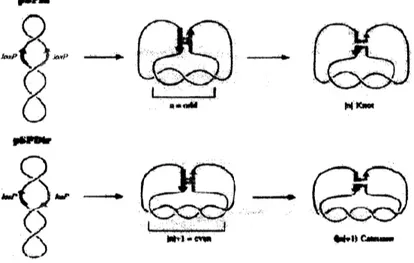

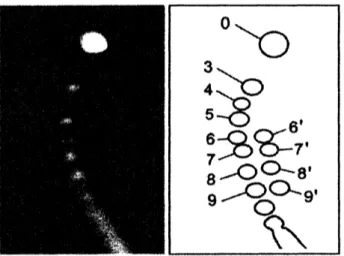
![Fig. 7 The results of the fractions of knots $3_{1},4_{1},5_{1}$ and $5_{2}$ by biological experiments [3]](https://thumb-ap.123doks.com/thumbv2/123deta/5990561.1060835/6.892.290.642.631.884/fig-results-fractions-knots-biological-experiments.webp)
